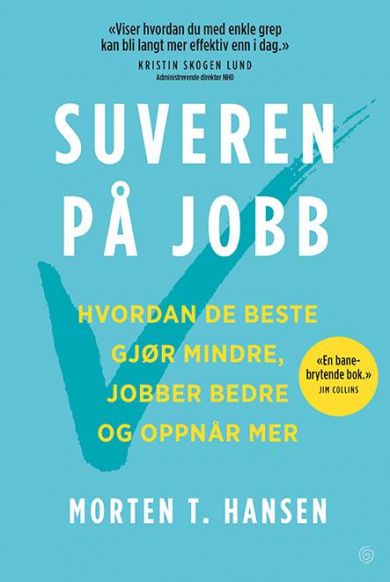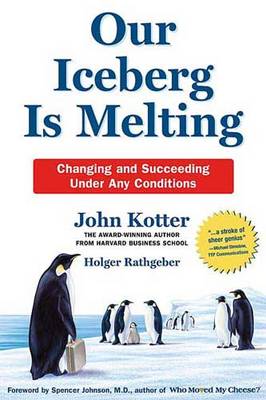A long-awaited vacation is just around the corner, and we finally have time to hunker down and recharge our batteries. Summer is also a great time for reflection and can be a perfect opportunity to dive into the world of literature.
General Manager of FRONT Leadership, Mats Kristensen, leadership developers Hildegunn Danielsen and Camilla Sommerfeldt Bentzen give you here their favorite leadership books that can help you on your way to becoming an even better leader.
The books they have selected are three very different books, which they believe many will both enjoy and benefit from. They recommend recommend a non-fiction book, a fable and a real-life story. The common denominator is that they all deal with leadership, but each in its own unique way and with a different approach.
Great at work
- by Morten T. Hansen
Recommended by Mats Kristensen
Description of the book
The key to success is not working harder. It's about working smarter. In this book, Morten T. Hansen debunks the myth that more effort means better results. Through inspiring stories, he gives you seven practical tips on how to get the most out of your working day. You will meet a businesswoman who increased her profitability by saying no to new customers, a school principal who got her school back on track after poor results, and a sushi chef in Tokyo who, with very simple means, got three stars in the Michelin Guide.
Well-founded and concrete
The book is backed by research. There are no opinions or random thoughts here, but concrete advice for those who want to be great at work. It is the best book Mats has read on self-management, and it has a good perspective that is set in a work context. He highlights a great rule of thumb: "do less, then obsess".
I think we have a lot to learn from that. How can you prioritize your time better and thus do what you're engaged in insanely well. Then you don't have to redo things because they weren't good enough. We can probably all save time by thinking that way," says Mats Kristensen.
Who should read it?
Anyone who wants to be great at work. The book is suitable for those who have ambitions and who want to achieve something, regardless of profession. As long as you have a desire to be really good, you'll get a lot out of this book.
Mats' personal tip for working smarter
The book is about working smart, tAnyone who manages to focus their energy on what is most important at any given timehas a lot to gain from it.
Energy can be money or time. It's what you invest. If you manage to get good quality by using as little energy as possible - that's smart in my book," he says.
Our Iceberg is Melting: Changing and Succeeding Under Any Conditions
- by John Kotter
Recommended by Hildegunn Danielsen
Description of the book
This is a story about doing well under stress and the uncertainty of abrupt change. The action takes place on an iceberg near the coast of Antarctica, where a group of emperor penguins live, just as they have done for many, many years. The penguins know no other life than the life they have on the iceberg. Then a curious bird discovers a potentially devastating problem that threatens their home - and hardly anyone listens to him.
The characters in the story describe personalities you probably recognize from your own organization, including yourself. It addresses resistance to change, heroic action, seemingly unattainable obstacles and smart tactics to deal with those obstacles.
Entertaining food for thought
This booka was suggested Hildegunn Danielsenone of FRONT Leadership's leadershipdevelopers. The story of the penguins is entertaining, and at the same time, many parallels can be drawn to everyday organizational life. The iceberg has an organizational structure and a hierarchy that is built up in the same way as in our own working life. John Kotter has both researched and written many books on change management, and with this fable he manages to explain some of the dynamics of change processes in an illustrative and metaphorical way.
When you're an expert and see something that's important for senior management to know, you must have the courage and energy to address it. Play your expert role to the fullest, no matter what industry you're in. Many people withhold information for fear of speaking up, and this can result in tragic outcomes," says Mats.
Who should read it?
This book has a broad appeal, and many people can read it. Anyone who is interested in change in organizations and change management will find it exciting. The story itself is very entertaining, and change is something most people have a relationship with.
Mats' personal tip for change management
Involving employees is always a good idea. That ownership and the trust you gain by involving others is worth a lot.
"If you want to walk fast, walk alone, if you want to walk far, walk together".
"If everyone is asked 'what do you think', that goes a long way," says Mats.
Want to read more about change management? Read also "Everyone is talking about change management"
Scott And Amundsen - The Last Place on Earth
- by Roland Huntford
Recommended by Camilla Sommerfeldt Bentzen
Description of the book
In this dual biography, award-winning author Roland Huntford examines every detail of Robert Scott and Roald Amundsen's great race to the South Pole. Scott, who dies with four of his men on the return trip, became Britain's beloved failure. Amundsen, who not only beat Scott to the South Pole but returned alive, was largely forgotten. This account of the race is a gripping story that captures the driving ambitions of the time and the complex men who carried them out.
Highlights different characteristics of leaders
This book ble promoted by Camilla Bentzen, another another leadership developer in FRONT Leadership. In this story, one can draw interesting parallels to functional and dysfunctional leadership in today's society. Perhaps especially with regard to authoritarian versus democratic leadership. Here we see Amundsen as a transformational leader who is a visionary. Scott, on the other hand, is described as a transactional leader who is detail-oriented. They are two very different leadership characters.
Amundsen is described as a disciplined, meticulous and steadfast leader, both in terms of planning the trip, testing equipment and all the preparations. But also when it comes to the actual execution. He sets himself a goal of "20 mile march" every day, which he accomplishes on both good and bad days.
Who should read it?
Those who want to get to know the story of Amundsen and Scott, and understand more of what really happened. This is an interesting real-life story with many parallels to today's society and leadership.
Mats' personal leadership tip
Amundsen worked towards "the overall greater good". The community was in focus. Scott, on the other hand, was more focused on himself and what he wanted to achieve as an individual.
I think that being predictable, thoughtful and responsive as a leader are good qualities.




